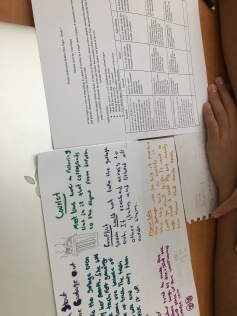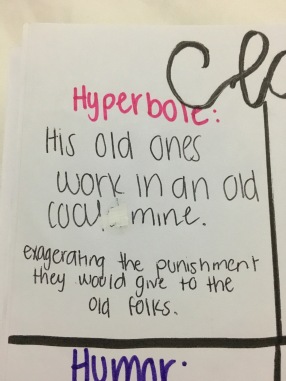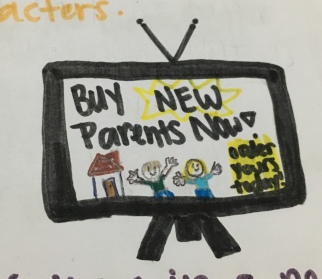I’m always trying to find valid, fun, and interesting ways to assess different reading standards without assigning essays or quizzes. This year, in addition to conferences, graded video discussions, and “short story clubs” (instead of book clubs), I’ve assigned one-pagers to my students.

Most recently, I assigned a one-pager to my grade seven students. We have been studying poetry for the last several weeks, reading, writing, and talking about it. We developed a list of words we should use in order to raise our discussions to a more academic level, and my students created a word wall with that list.
When it came time for a summative assessment over the poetry we’ve studied, I decided to assign a one-pager.
A one-pager is exactly what it sounds like: one page of illustrations and information which demonstrate the student’s understanding or reflection of whatever the topic and learning that has been studied and practiced in the previous unit. With seventh graders, I allow them to make their one-pagers larger than the typical A4 size paper, so sometimes their “one-pagers” end up more like “three-pagers”, but the idea is that they are a cohesive unit, and taped together as one large captioned illustration rather than a series of pages that are stapled together in the corner like an essay might be.
Before assigning the summative assessment, I assigned a practice one-pager. All three of my seventh grade classes practiced with Shel Silverstein’s Sarah Cynthia Silvia Stout Would not Take the Garbage Out. It was a big hit. It’s funny and chock-full of poetic devices. Plus, it’s relatable to seventh graders and has a nice lesson at the end.
We spent a couple of work sessions practicing, talking, coloring, writing and generally having a nice time learning and reflecting on what we have learned. During the third work session, I asked my students to self-assess their practice one-pagers, using the rubric, and writing on the back of their papers what they think they earned in each of the three categories.


The rubric covered three standards, so students weren’t overwhelmed by small pieces and tasks. There are requirements for this assignment, but still a lot of room for individual choice and creativity.

This extra day of working with the practice poem paid off. I overheard students having their own “ah-ha” moments, checking the word wall for definitions and ideas, and talking to each other about things like couplets and alliteration. The conversations were really fun to overhear.
When it came time to complete the summative assessment, my students were ready. Each class was given a different Shel Silverstein poem: Cloony the Clown, Clarence, or Sick. Each of these poems contains several of the poetic devices we studied, and were written by a familiar poet. The final products were knock-out. Below I’ve included a few samples.
This is one of the many ways I’ve used one-pagers as a tool for learning and as a tool for assessing. I’ll share more later, and I look forward to hearing about how you use them in your own classes!
Julie has been teaching secondary language arts for twenty years, spending the first fifteen in rural Central Oregon, and the last four in Amman, Jordan. She’s thrilled to report that she and her family have moved across the world to Managua, Nicaragua this year, where a new adventure has begun.
Follow her on twitter @SwinehartJulie




[…] brings me back to the last assessment of the first semester. I assigned a one-pager which included reflection, facts, rhetorical analysis, and art. Eleventh grade students don’t […]
LikeLike
[…] brings me back to the last assessment of the first semester. I assigned a one-pager which included reflection, facts, rhetorical analysis, and art. Eleventh grade students don’t […]
LikeLike
[…] shared some of my experiences with one-pagers before, and I thought I’d share another idea or two […]
LikeLike
[…] shared some of my experiences with one-pagers before, and I thought I’d share another idea or two […]
LikeLike